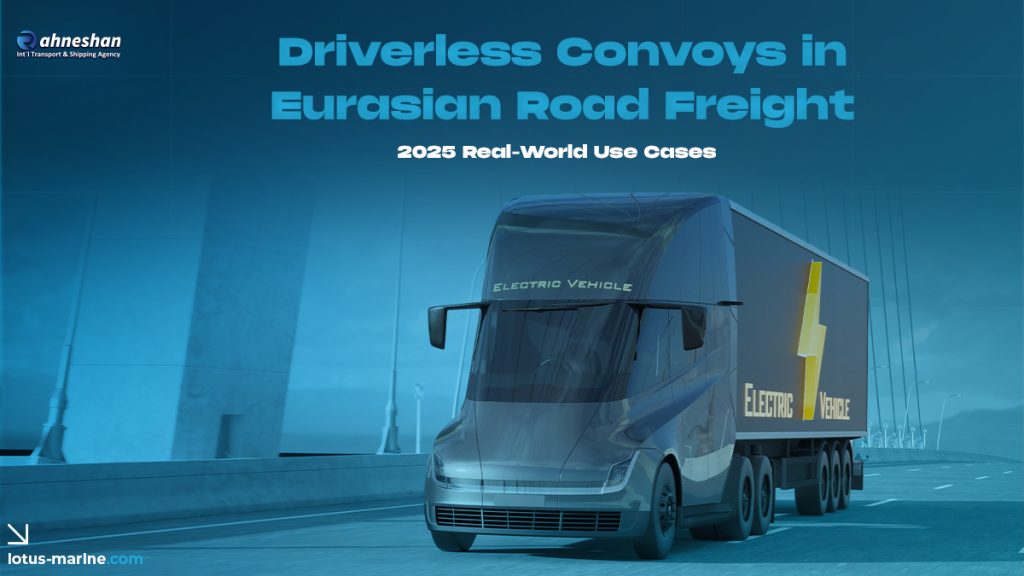Introduction
The rapid development of autonomous driving technology is transforming the logistics sector worldwide. In Eurasia, where sprawling trade routes connect Europe and Asia through vast highways, driverless truck convoys—also known as platooning systems—are emerging as a practical solution in 2025. By linking multiple trucks via AI and vehicle-to-vehicle (V2V) communication, these convoys promise enhanced efficiency, reduced costs, and safer cross-border freight transport.
What Are Driverless Convoys (Platooning)?
Driverless convoys involve a lead truck equipped with advanced autonomous navigation systems, followed by multiple self-driving trucks connected digitally. These vehicles accelerate, brake, and steer in sync, reducing fuel consumption and improving traffic safety.
Core Technologies Behind Convoys
-
AI-based navigation systems
-
V2V communication for synchronized movement
-
Lidar, radar, and camera sensors
-
Cross-border digital freight management systems
2025 Real-World Use Cases in Eurasian Road Freight
1. China–Europe Road Freight Corridors
Autonomous convoys are being deployed on segments of the China–Kazakhstan–Europe Belt and Road routes, cutting delivery times for electronics and consumer goods by reducing driver fatigue and mandatory rest stops.
2. Russia’s Long-Distance Highways
On Russia’s vast highway network, driverless convoys are transporting heavy industrial cargo such as steel, machinery, and energy equipment. Their use helps minimize accidents on remote routes with limited human oversight.
3. Turkey as a Logistics Bridge
Turkey, acting as a strategic hub between Europe and Asia, has piloted autonomous convoys for textile and automotive exports, integrating AI-driven border compliance systems to streamline customs clearance.
4. EU Pilot Programs
The EU is testing multi-brand platoons across Germany, Poland, and the Netherlands, focusing on cross-border harmonization of safety standards, digital tolling, and emissions reporting.
Benefits of Driverless Convoys
-
Fuel Savings: Reduced drag and synchronized driving can cut fuel use by up to 15%.
-
Lower Costs: Decreased reliance on human drivers for long hauls lowers labor expenses.
-
Enhanced Safety: Automation reduces accidents caused by driver fatigue.
-
Higher Efficiency: Continuous operation without mandatory rest periods.
-
Environmental Impact: Improved fuel efficiency reduces CO₂ emissions.
Challenges and Barriers
-
Regulatory Fragmentation: Different countries impose varying rules for autonomous vehicles.
-
Cybersecurity Risks: Convoys rely heavily on connected systems vulnerable to hacking.
-
Infrastructure Gaps: Some Eurasian routes lack the digital and physical infrastructure to support autonomy.
-
Public Acceptance: Concerns about safety and job losses slow widespread adoption.
Future Outlook
By 2030, Eurasian driverless convoys could become mainstream, especially along Belt and Road corridors. Integration with AI logistics platforms, dynamic tolling systems, and carbon tracking tools will make convoys a cornerstone of efficient, sustainable freight. Hybrid models—combining human oversight with autonomous driving—are expected to dominate the transition phase.
Conclusion
Driverless convoys are no longer futuristic concepts—they are becoming operational realities in Eurasian road freight. By reducing costs, improving safety, and supporting sustainability, these convoys are poised to redefine cross-continental trade routes. The challenge lies in harmonizing regulations, building infrastructure, and ensuring cybersecurity for a fully autonomous freight future.
Frequently Asked Questions
1. What is a driverless convoy in logistics?
A group of digitally connected trucks, led by a primary vehicle, driving autonomously in synchronization.
2. Are driverless convoys already in use in Eurasia?
Yes, pilot programs are active in China–Europe corridors, Russia, Turkey, and parts of the EU.
3. How do convoys improve efficiency?
They reduce fuel use, minimize rest stops, and enable synchronized, safe long-distance operations.
4. What are the main risks of autonomous convoys?
Cybersecurity vulnerabilities, regulatory inconsistency, and public acceptance challenges.
5. Will driverless convoys replace human drivers completely?
Not immediately. Human oversight will remain necessary, particularly for complex or urban routes.







